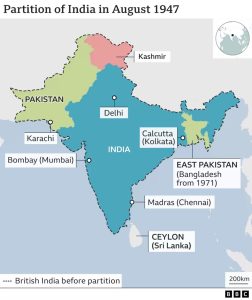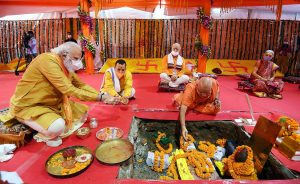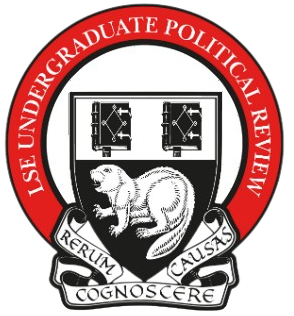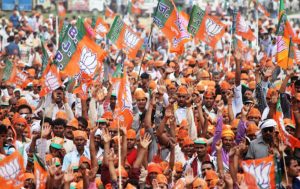In the heart of Ayodhya, a city where the tales of ancient champions and gods have echoed for centuries, rises a new monument – the Ram Mandir. This Hindu temple is being built close to the site that many believe to be the birthplace of Lord Ram, a central figure in Hindu culture. It was inaugurated by Prime Minister Modi on the 22nd of January in front of crowds of thousands of devout, adoring Hindus, just in time for the Indian general elections later this year. Events such as these lie at the centre of Prime Minister Modi’s strategy for a nation that honours its ancient roots while stepping into the uncertain future. However, despite being the new centrepiece of a religion steeped in thousands of years of history, these events represent much more than simple religious ventures. Across the city, Bharatiya Janata Party (BJP) flags wave alongside flags of Lord Ram, implying that the temple is an offering from the ruling party to the Hindu majority. It exemplifies a nuanced, strategic deployment of Hindu nationalism, with the construction and renovation of prominent Hindu temples serving as a cornerstone of their electoral strategy.
The Partition of India
Source: BBC
Before exploring the role of religion in modern Indian politics, one must first explore the secular roots of what we know today as the Republic of India.
As control of British India became untenable following two centuries of British rule, the partition plan was announced in 1947. This plan, developed under pressure from the Muslim League (which feared the persecution of Muslims in a Hindu-majority India), would divide the colony into two independent dominions – the Hindu-majority India, and the Muslim-majority Pakistan. The partition led to one of the largest and most violent mass migrations in human history, with millions of Hindus, Sikhs, and Muslims moving across the new borders, accompanied by horrific communal violence.
This instability prompted the first leaders of an independent India to build a secular democracy where all religions would be treated equally by the state. The Indian Constitution, adopted in 1950, enshrined secularism as a fundamental aspect of the country’s identity, mandating equality before the law, regardless of religion, caste, or creed. Today, about 80% of India’s population is Hindu, 14% are Muslim, and a smattering of other religions comprise the remaining 6%, making India one of the most religiously diverse nations in the world.
BJP supporters at an election rally in Amethi. / Image: Bharatiya Janata Party (distributed via CC BY-SA 2.0)
The Bharatiya Janata Party (BJP)
The BJP was officially formed in 1980, evolving from the Bharatiya Jana Sangh, which was founded in 1951. A central thrust of their political strategy included mobilisation around Hindu issues and appealing to the idea of a civilisational nation of India that is fundamentally Hindu. In that vein, they gained significant political traction in the late 1980s and early 1990s through their support of the Ram Janmabhoomi movement, which aimed to build the aforementioned Ram temple at the site of an existing mosque, the Babri Masjid, in Ayodhya. Subsequently, in 1992, the mosque (which was believed to have been built by Muslim conquerors on the birthplace of Lord Ram) was demolished by a group of Hindu nationalists and activists over, 400 years after it was built.
The demolition of the Babri Masjid in 1992, while not officially sanctioned by the BJP, was supported by many of its members and associated organisations, leading to widespread communal riots across India. This event was a pivotal moment that galvanised Hindu nationalist sentiments and significantly boosted the BJP’s popularity among Hindu voters. This former location of the Babri Masjid is also precisely the location where, after years of legal battle, the Ram Mandir rose. As far as Hindu revivalists were concerned, this was far greater than simply a political victory; this was a clash between cultures, a triumph over centuries of “Muslim oppression” enabled by a flawed (secular) government in the Congress party, and rectified by a strong (Hindu) government in the BJP.
The BJP leverages such ideas to expand its base, emphasising themes of Hindu identity and nationalism, which resonated with large segments of the population. The ideological foundation underpinning the BJP is the idea of Hindutva: an ideology that seeks to define Indian culture in terms of Hindu values. Modi, a clear proponent of this idea, encapsulates it through not only his rhetoric but his domestic policies. On the second anniversary of the Shri Kashi Vishwanath Corridor, a development project for an important pilgrimage destination for Hindus, Modi described it as a “resurrection of India’s civilisational glory”. This idea implies that India’s centuries-old Hindu roots should be central to India’s governance, while combining it with Modi’s desire to propel the country forward through his prioritisation of economic and urban development. On top of development projects such as these, laws such as the ban on cow slaughter in many BJP-governed states suggest an appeal to the idea of a Hindu-Indian state.
This allows the BJP election campaigns to often appeal directly to Hindu identity and sentiments. This includes portraying the party as the protector of Hindu rights and traditions, as well as portraying opponents as antithetical to Hindu interests or favouring minority communities at the expense of Hindus. This strategy was complemented by a broader appeal to economic development, national security, and good governance, which brought the party immense success. However, Hindu nationalism remains a central element of the BJP’s political strategy and aspirations. Although the dangers of such political strategies are present and apparent and will be discussed, it would be remiss to ignore the benefits these strategies could bring to a nation such as India.
The Dual Faces of Hindu Nationalism

Firstly, promoting Hindu nationalism helped to consolidate a sense of unity and pride among a significant portion of India’s population. Moreover, a convincing argument remains that emphasising Hindu values and traditions catalyses a revival of indigenous cultures and practices that were undermined over centuries of foreign rule and modern secular policies. Even for the minority populations of the country, Modi has repeatedly and unequivocally stated that there is “no space in India for religious discrimination” and outright denied its existence in India. Although possibly problematic in other ways, the pursuit of Hindutva may be able to unite India on a level that transcends mere politics.
Furthermore, the emphasis on certain values and principles could provide clear policy direction, particularly in areas like education, enabling a continuance of policy not subject to the myopic whims of electoral cycles. This emphasis on cultural values could be especially effective at a time when political polarisation is at a historically high level, aligning the nation’s direction.
However, there are clear threats that BJP’s political strategy poses as well. The secular basis of the Indian Constitution arose from the widespread communal violence that took place in the wake of independence – a basis that is being eroded by the apparent privileging of one religion over others. The promotion of this singular religious Indian identity can and has exacerbated communal tensions and social unrest. There have been increasing incidents of violence against minorities in India, which strongly correlates with the rise of Hindu nationalism.
This emphasis on Hindu nationalism could also cause a neglect of other broader issues. The will to cement and further religious goals may divert attention and resources away from other pressing national issues. Even if such issues are not overlooked, a significant proportion of national resources may be strategically used to benefit the majority Hindu population, such as through urban development of different regions, which undermines democratic principles.
Contrary to popular belief, but equally as problematic, the problem of an exclusive political focus on religious strategies undermines democratic opposition. This emphasis forces opposition coalitions to, first, oppose policies or events that a majority of the population is proud of, making the opposition even more unpopular. For example, the Indian National Congress boycotted the inauguration of the Ram Mandir, accusing the event of being a populist ploy. Secondly, opposition political parties are forced to focus primarily or even exclusively on religious issues without any policy substance in other domains due to the immediate concerns of securing an electoral victory.
Lastly, this religious focus has wider geopolitical impacts as well. Not only does undermining democratic values distance India from Western liberal (secular) states, but the apparent neglect of minority groups also leads to vehement opposition from other nations that are dominated by such minority groups. This threatens global peace and security, especially in a region as religiously diverse as South Asia.
Sacred Politics
The overarching danger lies in the populist polarisation that such ideals promote in a democratic society. The protection of minorities, granting them equal say and rights remains a foundational value that democratic societies hold. But why, indeed, does religion polarise and galvanise such huge portions of the population, and what makes it distinct from any other traditional socio-political movement like Marxism or Neoliberalism?
Simply put, it is because religion transcends man. Despite political ideologies such as Marxism being used to galvanise populations in similar ways to religion, it is fundamentally distinct in that it is attributable to man, and hence it is fallible. Policies based on religions, whose followers often believe come straight from a supernatural being such as God, are unquestionable. Moreover, such thought often deifies the leader that espouses these ideals, and again, the determinant of this is the word of God, interpreted through credible religious figures. Although this deification is less prominent when compared to the days of the divine right of kings, even Modi is viewed as an important authority figure partially due to his image as a religious leader determined to advance the Hindu cause.
Secularism is a rather recent concept, originating in Western liberal democracies, out of a need to justify the authority of the state without falling back to (disputed) theological premises. However, as we have established in this article, even now, they are arguably more often expressed as an ideal rather than practised, as seen by the prominence of religious lobbies, interest groups and political organisations affiliated with religion.
Secularization Theory suggests that “in the face of scientific rationality, religion’s influence on all aspects of life – from personal habits to social institutions – is in dramatic decline”. However, in the case of Modi’s India, the success of their political strategies betrays this theory. In fact, nearly 64% of adults in India regarded being Hindu as “very important” to be truly Indian, remaining high despite rapid urban and economic development. Functionalists, on the other hand, would argue for the positives that religion plays in social cohesion and unity. This, too, ignores the potential dysfunctions of religion, as can be seen by the othering of minorities in Modi’s India and the accompanying instability.
Conclusion
Despite the many theories that can be used to justify or criticise Modi’s political strategies, the Indian experience offers crucial insights into the complexities of managing religious diversity within a democratic framework. The growing dominance of religious politics in India, while serving short-term electoral strategies, poses long-term challenges to the fabric of Indian society and its democratic foundations. The global implications of this shift extend beyond India’s borders, influencing regional stability, international relations, and the broader discourse on democracy and secularism. As India navigates this complex terrain, the world watches closely, recognizing that the resolution of these challenges is critical not just for India’s future but for the maintenance of global peace and democratic principles.
As the Ram Mandir builds towards the skies, it is not just laying the foundations of modern Hinduism; it is laying down the blueprint for Modi’s India – one where tradition and progress walk hand in hand. However, it remains a physical reminder of the delicate balance between celebrating tradition and fostering an inclusive future for all.
by Ayush Das
Cover Image Source: Prime Minister Narendra Modi addressing the gathering at the foundation stone laying ceremony of Ram Temple by the Prime Minister’s Office via Wikipedia Commons







